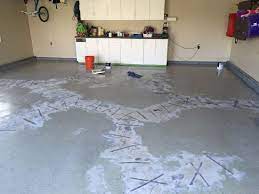Concrete is a strong and adaptable building material that is frequently used in both residential and commercial construction projects. However, a number of factors, such as age, weather, and heavy loads, can cause cracks and surface damage to concrete slabs over time. If these problems are not resolved, they may have an impact on the structural integrity of your property in addition to its aesthetics. This blog will discuss common causes of damage to concrete slabs, the value of prompt repairs, and practical ways to deal with surface damage and cracks.
Typical Reasons for Damage to Concrete Slabs
It’s critical to comprehend the typical causes of concrete slab damage before attempting any repairs. By identifying the root of the problem, you can take steps to prevent further damage and ensure the longevity of your concrete surfaces. These are a few common causes:
1. Settlement: Uneven surfaces and cracks may result from the soil beneath the concrete slab settling over time.
2. Freeze-Thaw Cycles: In colder climates, the expansion and contraction of concrete can result in surface deterioration and cracks.
3. Heavy Loads: Stress and subsequent cracking or damage can result from excessive weight or heavy machinery on concrete surfaces.
4. Chemical Exposure: Concrete’s surface can be eroded and its structure weakened by exposure to strong chemicals, such as oil, de-icing salts, or acidic substances.
5. Aging: Due to normal wear and tear, concrete slabs may naturally develop cracks and wear.
The Value of Prompt Concrete Slab Restoration
It’s critical to fix surface damage and cracks in your concrete building slabs Charlotte for a number of reasons:
1. Structural Integrity: The flooring or foundation of your building may become compromised by damage or cracks. Timely fixes stop these problems from getting worse and maybe becoming bigger structural issues.
2. Safety: Falling or tripping over damaged concrete surfaces is a risk. Timely maintenance is essential to keeping both residents and guests safe.
3. Aesthetics: Your property’s appearance can be greatly impacted by cracked or deteriorating concrete. Your concrete surfaces’ aesthetic appeal can be restored with repairs.
4. Cost Savings: Early problem solving can result in long-term financial savings. In general, minor repairs are less expensive than major replacements or structural adjustments.
Successful Concrete Slab Repair Techniques
Various methods and materials are used in concrete slab repairs, depending on the nature of the issue and the degree of damage. The following are some efficient techniques for fixing surface damage and cracks in concrete slabs:
1. Crack Filling and Sealing: These are two common repair techniques for minor, non-structural cracks. Cracks are filled with specialized concrete sealants to stop moisture seeping in and causing more damage.
2. Concrete Resurfacing: Concrete resurfacing is a viable option for small wear or damage to a concrete slab’s surface. To create a new, smooth surface, this entails applying a thin layer of freshly concrete or an overlay modified with a polymer.
3. Concrete Patching: Patching is appropriate for small holes or areas of localized damage in concrete surfaces. To preserve the integrity of the surface, it entails filling the damaged area with concrete patching compound.
4. Concrete Grinding and Polishing: These techniques can be used to remove surface flaws, unevenness, or cosmetic concerns. Using this technique, the surface is first polished to create a glossy, smooth finish, and any imperfections are then ground away.
5. Reinforcement with Epoxy Injection: Epoxy injection can be used to repair structural cracks in concrete, bringing it back to its previous strength. The damaged area is bonded and reinforced by the injection of epoxy resin into the crack.
6. Mudjacking or Slabjacking: Slabjacking, also known as mudjacking, is a good technique for uneven or sunken concrete slabs caused by settling. The slab is injected with a grout mixture to raise it back to its initial position.
7. Concrete Overlay: A concrete overlay can offer a long-lasting and stylish solution in situations where there is significant surface wear or damage. In order to create a new surface, a fresh layer of concrete must be applied over the current slab.
Selecting the Appropriate Repair Technique
The kind and degree of the damage, as well as your unique objectives, will determine which repair technique is best. When choosing the best repair technique, keep the following things in mind:
1. Sort of Damage: Determine the kind of harm that your concrete slab has experienced. Is it wear and tear on the surface, a minor crack in the surface, or a structural crack? The best repair technique will depend on the type of damage.
2. Damage Amount: Take into account the quantity and degree of the harm. While smaller cracks can be filled and sealed, larger structural problems might need more involved repairs.
3. Budget: The type of repair you choose will also depend on your financial situation. Certain techniques, like concrete overlay, might need a bigger investment, while others, like crack filling and sealing, are more cost-effective.
4. Aesthetics: Select a repair technique that can produce the appropriate appearance if aesthetics are important. Concrete polishing and grinding are two techniques that can improve the surface’s aesthetic appeal.
5. Longevity: Take into account how long the repair should last. Choose a method based on your long-term objectives, as some may yield results that are more durable than others.
6. Professional Assessment: To determine the best course of action for repairing the damage, it is recommended that you speak with a structural engineer or professional concrete contractor, find more info about Venture Concrete Charlotte.
Avoiding More Damage
After treating the surface damage and cracks in your concrete slabs, you must take preventive action to reduce further problems. The following advice may be used to lessen future harm:
1. Regular Maintenance: Give your concrete surfaces a regular maintenance schedule. To identify problems early, this may entail inspections, sealing, and cleaning.
2. Appropriate Drainage: To avoid water buildup that could cause damage, make sure your concrete surfaces have adequate drainage.
3. Avoid Heavy Loads: To avoid stress and cracking, spread out weight evenly and be aware of any heavy machinery or vehicles on your concrete surfaces.
4. Use Sealants: To shield the surface from chemicals, moisture, and other environmental elements, apply sealants to concrete.
5. Temperature Control: Because de-icing agents can exacerbate surface damage, use caution when applying them in areas with significant temperature swings.
In conclusion, maintaining the structural integrity, safety, beauty, and value of your property depends on taking care of surface damage and cracks in your concrete slabs. Numerous repair techniques are available, ranging from concrete overlay and reinforcement with epoxy injection to crack filling and sealing, depending on the kind and degree of the damage. Selecting the best repair technique necessitates a thorough evaluation of the damage, financial planning, aesthetic objectives, and professional experience.
In the end, you can safeguard your investment and the security of your occupants and guests by taking prompt action to address concrete slab damage and putting preventive measures in place.










